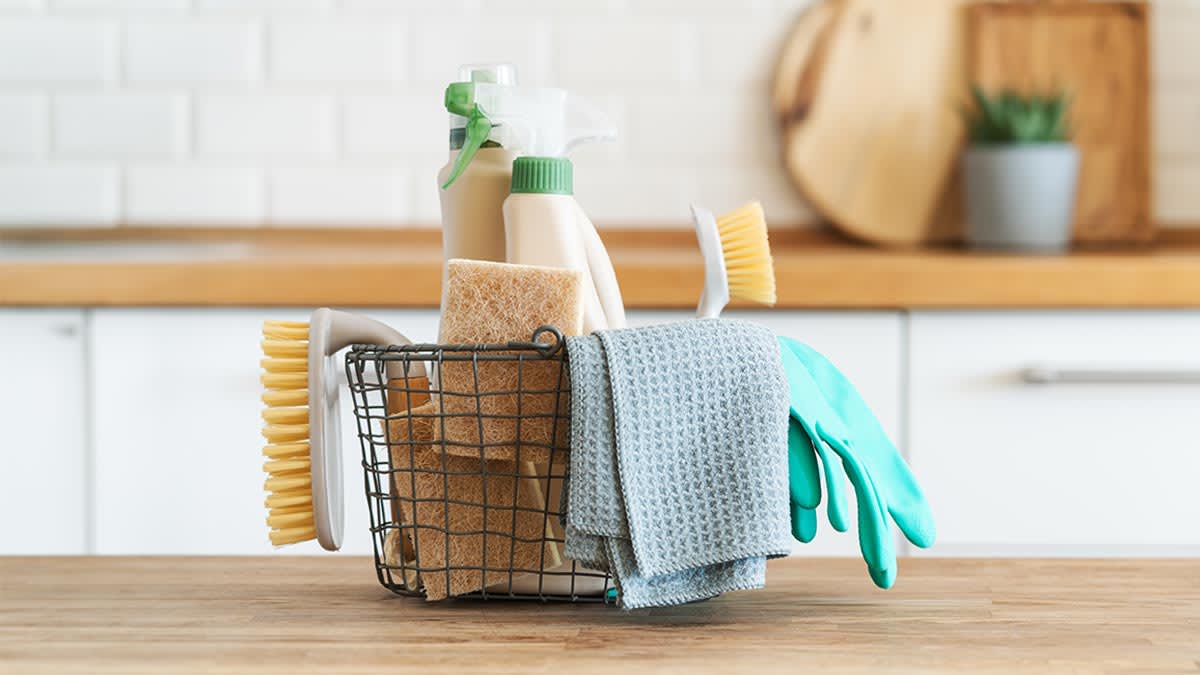Consider an all-purpose cleaner. Despite what product marketing may tell you, a different cleaner isn’t necessary for every surface in your house. An effective all-purpose cleaner will handle almost every job including kitchen counters, floors, toilets, and bathtubs. This will not only reduce the bulk in your cleaning cabinet but also reduce the number of ingredients you’re exposed to.
Select cleaners with ingredients listed on the packaging. Because current federal legislation doesn’t require companies to include cleaning product ingredients there, not all do. Some use catchall or category terms instead of identifiable ingredient names. What to look for and avoid are nonspecific ingredient terms like “surfactant,” “dye,” “enzyme,” “carrier,” “cleaning agent,” “fragrance,” and other ambiguous language. By choosing products with disclosed ingredients, you know more about what you and your family are being exposed to.
Go fragrance-free. Because the components of a fragrance are not always required to be listed on labels, fragrances can contain hundreds of hidden ingredients, many of which have been associated with a host of health problems, including endocrine disruption, cancer, and developmental toxicity. Plus, fragranced cleaning products can also contribute to indoor air pollution.
Shop for simple cleaners. Product labels can be full of hard-to-decipher ingredients. One trick is to look for soap-based cleaners, which contain plant oils that have been saponified (turned into soap). Some of the most common examples you’ll find listed on labels are potassium cocoate, sodium cocoate, saponified coconut oil, sodium palmate, potassium palmate, and saponified palm oil (look for products with labels that declare they have sustainable palm oil). Another trick is to look for ingredients with “glucoside” listed in their names because they are gentle cleansing ingredients that are often plant-based. Some examples include decyl glucoside, lauryl glucoside, coco glucoside, caprylyl/capryl glucoside, and caprylyl/myristyl glucoside. This isn’t a perfect approach, but it can help you avoid questionable cleaning chemicals. Look for one or more of these ingredients as one of the first ingredients on the label.
Avoid cleaners containing dyes and colorants. The color in a cleaning solution doesn’t typically contribute to its effectiveness, so it’s just another unnecessary chemical exposure. Plus, some colorants commonly used in cleaners have been linked to asthma, skin sensitization, irritation, and a lack of biodegradability. Sometimes you’ll find colorants listed on labels, but they’re often protected by trade secrets and are not disclosed. But a bright-colored formulation can be a dead giveaway because it typically requires colorants to achieve those vivid hues. Not all colorants are harmful, but staying away from colored formulations is a simple rule to remember for easier shopping.
Choose safer disinfecting active ingredients listed as the active ingredient on disinfectant labels. Those include ingredients like hydrogen peroxide (at least 3 percent), ethanol (at least 70 percent), or citric acid (at least 0.5 percent). These are all active ingredients registered with the Environmental Protection Agency to fight against various common pathogens. They can be better choices than commonly used harsh ones like ammonium quaternary compounds, which are increasingly being recognized as chemicals of concern. They can be identified on labels by the term “quaternium” or “-onium chloride” in the name.
Experiment with a vinegar-based solution for windows and glass. While all-purpose cleaners will cover many jobs, glass is a notable exception. A simple mixture of equal parts vinegar and hot water can be a safe alternative. (Just make sure the spray bottle never contained bleach, ammonia, or hydrogen peroxide.) It may not work as well as a traditional stand-alone glass cleaner, but can be less likely to contain worrisome ingredients. And note that there are some things that you should not clean with vinegar, including many appliances and countertops, because its acidity could cause damage.
Check ingredients lists on company websites. The California law that requires companies to list harmful cleaning product ingredients on the labels of products sold in the state also requires companies to include this information on their websites, so you can find that information if you live elsewhere. California’s list of harmful ingredients isn’t exhaustive, so products can still contain problematic chemicals.
Look for products certified to be safer for people and the planet. They include those certified by Made Safe. Another good starting point is the EPA’s Safer Choice. Products carrying this label use ingredients verified by the agency to be safer than most conventional options.
Source link
